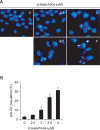β-lapachone-Induced Apoptosis of Human Gastric Carcinoma AGS Cells Is Caspase-Dependent and Regulated by the PI3K/Akt Pathway
- PMID: 25009698
- PMCID: PMC4060078
- DOI: 10.4062/biomolther.2014.026
β-lapachone-Induced Apoptosis of Human Gastric Carcinoma AGS Cells Is Caspase-Dependent and Regulated by the PI3K/Akt Pathway
Abstract
β-lapachone is a naturally occurring quinone that selectively induces apoptotic cell death in a variety of human cancer cells in vitro and in vivo; however, its mechanism of action needs to be further elaborated. In this study, we investigated the effects of β-lapachone on the induction of apoptosis in human gastric carcinoma AGS cells. β-lapachone significantly inhibited cellular proliferation, and some typical apoptotic characteristics such as chromatin condensation and an increase in the population of sub-G1 hypodiploid cells were observed in β-lapachone-treated AGS cells. Treatment with β-lapachone caused mitochondrial transmembrane potential dissipation, stimulated the mitochondria-mediated intrinsic apoptotic pathway, as indicated by caspase-9 activation, cytochrome c release, Bcl-2 downregulation and Bax upregulation, as well as death receptor-mediated extrinsic apoptotic pathway, as indicated by activation of caspase-8 and truncation of Bid. This process was accompanied by activation of caspase-3 and concomitant with cleavage of poly(ADP-ribose) polymerase. The general caspase inhibitor, z-VAD-fmk, significantly abolished β-lapachone-induced cell death and inhibited growth. Further analysis demonstrated that the induction of apoptosis by β-lapachone was accompanied by inactivation of the phosphatidylinositol 3-kinase (PI3K)/Akt signaling pathway. The PI3K inhibitor LY29004 significantly increased β-lapachone-induced apoptosis and growth inhibition. Taken together, these findings indicate that the apoptotic activity of β-lapachone is probably regulated by a caspase-dependent cascade through activation of both intrinsic and extrinsic signaling pathways, and that inhibition of the PI3K/Akt signaling may contribute to β-lapachone-mediated AGS cell growth inhibition and apoptosis induction.
Keywords: Apoptosis; Caspase; PI3K/Akt; β-lapachone.
Figures







Similar articles
-
Diallyl trisulfide-induced apoptosis of bladder cancer cells is caspase-dependent and regulated by PI3K/Akt and JNK pathways.Environ Toxicol Pharmacol. 2014 Jan;37(1):74-83. doi: 10.1016/j.etap.2013.11.002. Epub 2013 Nov 9. Environ Toxicol Pharmacol. 2014. PMID: 24309133
-
Release of mitochondrial cytochrome C in both apoptosis and necrosis induced by beta-lapachone in human carcinoma cells.Mol Med. 1999 Apr;5(4):232-9. Mol Med. 1999. PMID: 10448645 Free PMC article.
-
Sanguinarine Induces Apoptosis of Human Oral Squamous Cell Carcinoma KB Cells via Inactivation of the PI3K/Akt Signaling Pathway.Drug Dev Res. 2016 Aug;77(5):227-40. doi: 10.1002/ddr.21315. Epub 2016 Jul 1. Drug Dev Res. 2016. PMID: 27363951
-
Cordycepin induces apoptosis in human bladder cancer T24 cells through ROS-dependent inhibition of the PI3K/Akt signaling pathway.Biosci Trends. 2019;13(4):324-333. doi: 10.5582/bst.2019.01214. Biosci Trends. 2019. PMID: 31527329
-
Mechanism of PI3K/Akt‑mediated mitochondrial pathway in obesity‑induced apoptosis (Review).Biomed Rep. 2024 Dec 27;22(3):40. doi: 10.3892/br.2024.1918. eCollection 2025 Mar. Biomed Rep. 2024. PMID: 39781039 Free PMC article. Review.
Cited by
-
Knockdown of CLDN6 inhibits cell proliferation and migration via PI3K/AKT/mTOR signaling pathway in endometrial carcinoma cell line HEC-1-B.Onco Targets Ther. 2018 Oct 1;11:6351-6360. doi: 10.2147/OTT.S174618. eCollection 2018. Onco Targets Ther. 2018. PMID: 30319275 Free PMC article.
-
X-ray repair cross-complementing protein 1 (XRCC1) loss promotes β-lapachone -induced apoptosis in pancreatic cancer cells.BMC Cancer. 2021 Nov 17;21(1):1234. doi: 10.1186/s12885-021-08979-y. BMC Cancer. 2021. PMID: 34789190 Free PMC article.
-
Decreased Poly(ADP-Ribose) Polymerase 1 Expression Attenuates Glucose Oxidase-Induced Damage in Rat Cochlear Marginal Strial Cells.Mol Neurobiol. 2016 Nov;53(9):5971-5984. doi: 10.1007/s12035-015-9469-7. Epub 2015 Nov 2. Mol Neurobiol. 2016. PMID: 26526840 Free PMC article.
-
Anticancer Potential and Safety Profile of β-Lapachone In Vitro.Molecules. 2024 Mar 21;29(6):1395. doi: 10.3390/molecules29061395. Molecules. 2024. PMID: 38543031 Free PMC article.
-
Artemisia annua L. Polyphenols Enhance the Anticancer Effect of β-Lapachone in Oxaliplatin-Resistant HCT116 Colorectal Cancer Cells.Int J Mol Sci. 2023 Dec 15;24(24):17505. doi: 10.3390/ijms242417505. Int J Mol Sci. 2023. PMID: 38139333 Free PMC article.
References
-
- Ang KL, Shi DL, Keong WW, Epstein RJ. Up-regulated Akt signaling adjacent to gastric cancers: implications for screening and chemoprevention. Cancer Lett. 2005;225:53–59. - PubMed
-
- Binutu OA, Adesogan KE, Okogun JI. Antibacterial and antifungal compounds from Kigelia pinnata. Planta Med. 1996;62:352–353. - PubMed
-
- Boothman DA, Trask DK, Pardee AB. Inhibition of potentially lethal DNA damage repair in human tumor cells by β-lapachone, an activator of topoisomerase I. Cancer Res. 1989;49:605–612. - PubMed
-
- Carnero A, Blanco-Aparicio C, Renner O, Link W, Leal JF. The PTEN/PI3K/AKT signalling pathway in cancer, therapeutic implications. Curr. Cancer Drug Targets. 2008;8:187–198. - PubMed
LinkOut - more resources
Full Text Sources
Other Literature Sources
Research Materials

